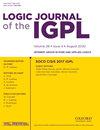非同余模态逻辑的高内涵模型
IF 0.8
4区 数学
Q2 LOGIC
引用次数: 0
摘要
在这项工作中,我们说明了基于高内涵模型的非同余模态逻辑的语义框架的应用。我们首先讨论这种方法背后的一些哲学思想;特别是,公式为真的可能世界集(其强度)与公式的语义内容(其高强度)之间的差异,后者在高强度模型中以严格的方式捕获。接下来,我们严格地说明了这种方法,并提供了一个基本的完备性定理。此外,我们分析了非同余系统的例子,这些系统可以在这个框架内以优雅和模块化的方式进行语义表征。最后,我们将提出的框架与文献中可用的一些替代方案进行比较。根据所获得的结果,我们认为高内涵模型构成了(非同余)模态逻辑的基本、一般和统一的语义框架。本文章由计算机程序翻译,如有差异,请以英文原文为准。
Hyperintensional models for non-congruential modal logics
Abstract In this work, we illustrate applications of a semantic framework for non-congruential modal logic based on hyperintensional models. We start by discussing some philosophical ideas behind the approach; in particular, the difference between the set of possible worlds in which a formula is true (its intension) and the semantic content of a formula (its hyperintension), which is captured in a rigorous way in hyperintensional models. Next, we rigorously specify the approach and provide a fundamental completeness theorem. Moreover, we analyse examples of non-congruential systems that can be semantically characterized within this framework in an elegant and modular way. Finally, we compare the proposed framework with some alternatives available in the literature. In the light of the results obtained, we argue that hyperintensional models constitute a basic, general and unifying semantic framework for (non-congruential) modal logic.
求助全文
通过发布文献求助,成功后即可免费获取论文全文。
去求助
来源期刊
CiteScore
2.60
自引率
10.00%
发文量
76
审稿时长
6-12 weeks
期刊介绍:
Logic Journal of the IGPL publishes papers in all areas of pure and applied logic, including pure logical systems, proof theory, model theory, recursion theory, type theory, nonclassical logics, nonmonotonic logic, numerical and uncertainty reasoning, logic and AI, foundations of logic programming, logic and computation, logic and language, and logic engineering.
Logic Journal of the IGPL is published under licence from Professor Dov Gabbay as owner of the journal.

 求助内容:
求助内容: 应助结果提醒方式:
应助结果提醒方式:


